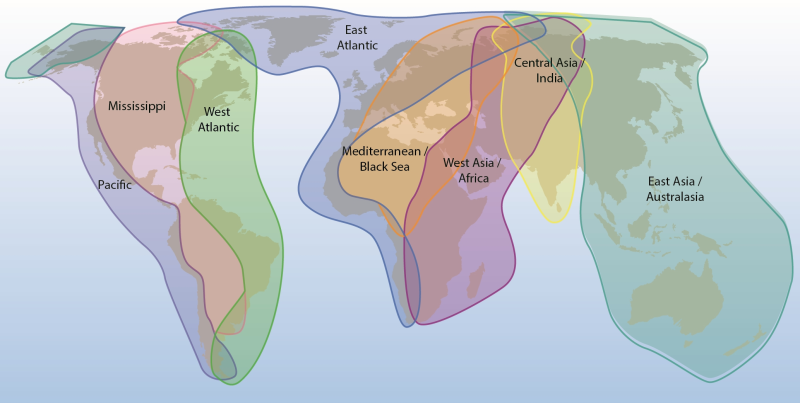migration
Type of resources
Available actions
Topics
Keywords
Contact for the resource
Provided by
Formats
Representation types
Update frequencies
status
-

Arctic Biodiversity Assessment (ABA) 2013. Figure 4.2. Major flyways of Arctic birds. Bird migration links Arctic breeding areas to all other parts of the globe (adapted from ACIA 2005). Conservation of Arctic Flora and Fauna, CAFF 2013 - Akureyri . Arctic Biodiversity Assessment. Status and Trends in Arctic biodiversity. - Birds(Chapter 4) page 146
-

<img src="http://geo.abds.is/geonetwork/srv/eng//resources.get?uuid=59d822e4-56ce-453c-b98d-40207a2e9eec&fname=cbmp_small.png" alt="logo" height="67px" align="left" hspace="10px">This index is part of CAFFs Arctic Species Trend Index (ASTI) which is an index that tracks trends in over 300 Arctic vertebrate species and comprises the Arctic component of the Living Planet Index. The ASTI describes overall trends across species, taxonomy, ecosystems, regions and other categories. This Arctic Migratory Birds Index describes the broad-scale trends necessary for designing and targeting informed conservation strategies at the flyway level to address these reported declines. To do this, it examines abundance change in selected Arctic breeding bird species, incorporating information from both inside and outside the Arctic to capture possible influences at different points during a species’ annual cycle. - <a href="http://caff.is" target="_blank"> Arctic Migratory Birds Index 2015</a>
-

The wildlife values area and site datasets represent the consolidation of 13 wildlife data classes collected by the Ministry of Natural Resources. The data estimates locations used by wildlife for various reasons, including: * breeding * calving and fawning * denning * feeding * staging * nesting * wintering * general habitat areas * nurseries * travel corridors Locations are represented as points (site) or polygons (area) and may be related to a specific species or described more generally. Wildlife values data is most often used to support policy and legislation associated with the Crown Forest Sustainability Act. The data may also be used to inform a wide range of resource management activities and decisions. There are additional sensitive features related to provincially tracked species and species at risk that are not available as part of the open data package. Sensitive features are subject to licensing and approvals and may be requested by contacting [geospatial@ontario.ca](geospatial@ontario.ca).
-

Fisheries and Oceans Canada (DFO) has been conducting surface water trawl surveys since 1992 in the coastal waters of British Columbia, Washington, Oregon and Alaska and in the high seas of the Gulf of Alaska. These surveys initially focused on determining the migratory patterns (1992-2002) and on the growth and physiology (2003-2016) of juvenile Pacific Salmon. Data collected in shelf and slope waters at depths less than 400 meters off Washington and Oregon State are part of this larger survey series, but are limited to 1999-2001. These surveys focused on determining the migratory patterns of juvenile Pacific Salmon and had funding support from the Bonneville Power Administration as part of the 1995-2011 Canada-USA Salmon Shelf Survival Study. The intent of that study was to monitor and evaluate the effects of ocean conditions on the distribution, migration, growth, and survival of Pacific salmon during their first ocean year, and estimate the subsequent impacts on abundance of Chinook salmon adults returning to the Columbia River system.
 Arctic SDI catalogue
Arctic SDI catalogue